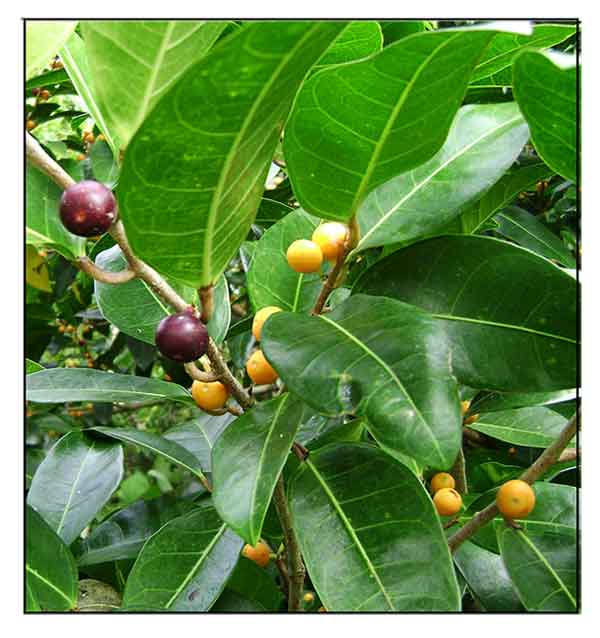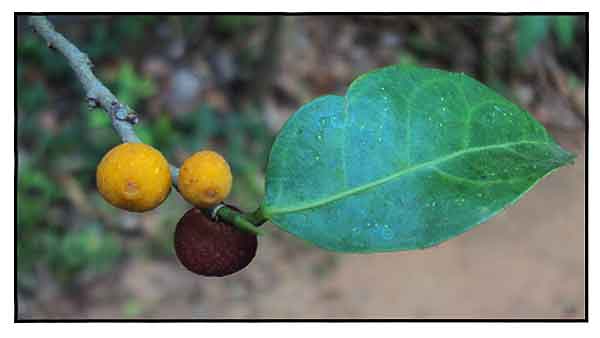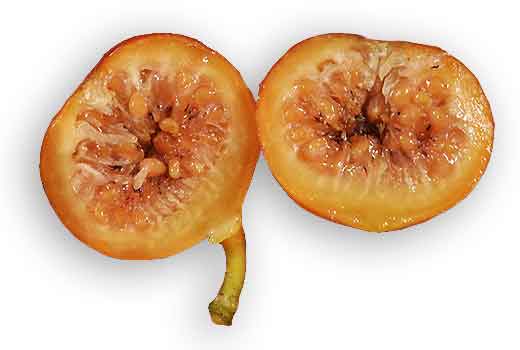Gen info
- Ficus tinctoria is a hemiepiphytic tree of the genus Ficus. It is one of the species known as straggler fig. Palms are favorite host species. While the root systems of the dye fig can come together to be self sustaining, the epiphyte usually falls if the host tree dies or rots away. (4)
 Botany Botany
Ficus tinctoria is a tree, small tree, or shrub, sometimes epiphytic. Bark slightly coarse. Branchlets brown. Stipules subulate-lanceolate, 5-10 mm, thick. Leaves distichous; petiole thick, 8-10 mm; leaf blade elliptic to ovate-elliptic, asymmetric, 3-13 × 2.5-6 cm, larger in juvenile plants, ± leathery to stiffly leathery, abaxially slightly rough, glabrous, base broadly cuneate to ± cordate, margin entire or toothed, apex obtuse to acute; venation abaxially conspicuous, not dark brown when dry; basal lateral veins short, secondary veins 5-8 on each side of midvein, and prominent on both surfaces. Figs axillary on normal leafy shoots, solitary or paired, globose to globose-pear-shaped, or ± pear-shaped, 8-10 mm in diam., with sparse small tubercles, slightly rough, base attenuate into stalk, apical pore navel-like; peduncle very short; involucral bracts ovate, margin revolute when dry. Male flowers: near apical pore; calyx lobes 4-6, white, linear; stamen 1; rudimentary ovary present. Gall flowers: calyx lobes 4-6, similar to male flowers; ovary obliquely ovoid; style lateral. Female flowers: calyx lobes 4, thin, transparent, linear; style persistent, lateral, short; stigma enlarged. Achenes ellipsoid, keeled, with tubercles. (Flora of China) (2)
 Ficus tinctoria is a large tree, up to 45 m tall, epiphytic when young, developing many slender aerial roots from the trunk together with many host-strangling basketing roots. Leaf-blade narrowly elliptical, 8-21 cm × 2-9 cm, generally unequally sided and distinctly angled; petiole 0.5-1 cm long. Fruit a fig, subglobose, ca. 1 cm in diameter, orange. (3) Ficus tinctoria is a large tree, up to 45 m tall, epiphytic when young, developing many slender aerial roots from the trunk together with many host-strangling basketing roots. Leaf-blade narrowly elliptical, 8-21 cm × 2-9 cm, generally unequally sided and distinctly angled; petiole 0.5-1 cm long. Fruit a fig, subglobose, ca. 1 cm in diameter, orange. (3)
Distribution
- Native to the Philippines.
- Common on rocky sea coasts, in primary and secondary forests, up to 1200 m altitude.
(3)
Constituents
- No studies found
Properties
- Studies have suggest antioxidant, antidiabetic properties.
 Parts used Parts used
Leaves, root, bark, stems.
Uses
Edibility
- Fruit is edible. Used in puddings and making dried preserves.
- In the low-lying atolls of Micronesia and Polynesia, it is a major food source.
(4)
Folkloric
- Decoction of juice and leaves used as tonic for postpartum weakness.
- Leaves used as poultice for broken bones.
- Bark and root of F. tinctoria gibbosa is astringent, used for treatment of diarrhea, menorrhagia, constipation, fever. (5)
- In India, young leaves are inserted in the ears as antidote for snake bites. For leucorrhea, stem bark juice (20cc) drunk before breakfast for three days.
- In Yap, roots used as stimulant for the intense pains of childbirth: ten pieces of root about 30 cm long, with skin off, are ground with coconut oil and taken with coconut milk.
(10)
- In Keral, India, the Madayipara tribals use stem and leaf juice as internal remedy for convulsions and weakness. (11)
- In Samoa, juice of inner bark instilled into eye for ma'i mata. (12)
Others
- Dye: Rust-brown fruit is a source of red dye used in traditional fabric making in parts of Oceania and Indonesia. (4)
- Fiber: Fiber from bark used for making cordage.
- Polish: Leaves used to polish ivory. (5)
Studies
• Antioxidant / Stems: Study evaluated the antioxidant activity of various extracts of stems of Ficus tinctoria using DPPH antioxidant assay, ABTS radical scavenging assay, and superoxide radical scavenging assay. A hydroalcoholic extract of stem showed an IC50 of 93,39 µg/ml with DPPH assay and good radical scavenging activity by ABTS assay with IC50 of 20.78 µg/ml, and IC50 70.42 µg/ml in superoxide radical scavenging assay. (6)
• Antidiabetic / Leaves: Study evaluated the antidiabetic activity of Ficus tinctoria leaf extracts in both polar and non-polar solvents. Among all extracts, the hydroalcoholic and methanolic extracts showed efficient antidiabetic activity. The ME showed an IC50 of 460 µg/ml for alpha-amylase inhibitory activity, and IC50 of of 90.60 µg/ml for alpha-glucosidase inhibitory activity. The hydroalcoholic extract showed IC50s of 90.60 µg/ml and 362 µg/ml for alpha-glucosidase and alpha-amylase inhibitory activities, respectively. (7)
• Antioxidant / Leaves: Study evaluated the antioxidant activity of aqueous and ethanolic extracts of Ficus gibbosa Blume by DPPH assay, ABTS assay, hydroxyl radical scavenging activity, superoxide free radical scavenging activity, nitric oxide radical scavenging activity and total antioxidant methods. Among the extracts, the aqueous extract showed better antioxidant activity. A compound 3, 4ˈ , 5, 7-tetrahydroxy-6-methyl flavone was isolated from the ethanolic extract (fraction 98-103). (8)
Availability
Wild-crafted.
|

![]()






